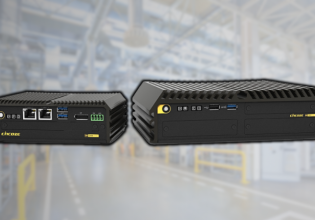FANUC Adds 5-Axis Milling Features to its Machining Simulation Platform
The simulation platform helps train CNC operators, allowing virtual development and testing of part programming.
The platform can serve as a pivotal solution to reduce overall waste and the risk of accidental damage to equipment and machines. FANUC adds new features to its Machining Simulation for Workforce Development for manufacturing personnel to emulate CNC milling and lathe operations in a virtual environment. The solution allows for more flexibility in testing without potentially compromising the well-being of actual CNC machines.
FANUC’s Machining Simulation Software
The software virtualizes five different machine tool types, which includes standard 3-axis milling and 2-axis lathes. The newest additions to the program include some of the most common 5-axis milling machines: mixed-type, tool-type, and table-type milling machines.

FANUCs table type simulation. Image courtesy of FANUC.

FANUCs tool type simulation. Image courtesy of FANUC.
The Machining Simulation software lets operators control the functions of their virtual CNC machine. The digital twin, rendered via the company’s CNC Guide PC-based software, shows every step of the CNC process on a PC screen. Additionally, operators can use FANUC’s MANUAL GUIDE i, a conversational and graphical programming software that generates G-code.
Used with CNC Guide, MANUAL GUIDE i can be used as a CAD/CAM package to enable part programming on a PC, so machines can be kept in operation. An operator can output all the parameter settings and the programs from a real machine tool into a PC via CNC Guide to simulate that machine.
”You can virtualize your conversational programming and test it out in the virtual machine tool, save that program, go out to a real machine tool that has the same setup and run that part with the understanding that you tested it in advance,” says Paul Webster, CNC Engineering Manager, FANUC America.
Easy Software Setup to Emulate Machine Tools
The Machining Simulation for Workforce Development software virtualizes five different generic machine types, so operators might have to modify the settings, such as the stroke limits and size, to produce a more accurate digital twin.
“The Machining Simulation is a PC-based software that runs a virtualized machine tool,” says Paul Webster, CNC Engineering Manager, FANUC America. “It simulates the motion of real machine tools.”
The Machining Simulation offers a hands-on training opportunity for students and trainees to learn how to create part programs.
“CNC Guide is a virtualized CNC,” says Webster. “It’s the control interface that would be on those virtualized machines. We brought them all into the PC world where you have a virtualized CNC and a virtualized machine.”
Users can have the virtualized CNC on one PC screen and the virtualized machine on the other. When the CNC is programmed, the machine will move and cut the part exactly like it would in the real world – all without actually using the machine.
With the ability to virtually execute the CNC milling and lathe processes on the PC, the Machining Simulation solution can also be used to teach programmers how to manage FANUC CNC’s advanced control features, including cycle-time estimation.
FANUC’s Hardware Simulator for CNC Operations and Programming Education
The main purpose of FANUC’s Machining Simulation for Workforce Development is to train the operators as well as to connect with high school and college-aged students in a way that will allow them to understand advanced manufacturing and automation of modern machines, says Webster.
The Machining Simulation software can be also be used with FANUC’s CNC education simulator. The CNC education simulator is designed specifically for educational purposes, ensuring affordable access to the latest FANUC CNC platform in a compact and portable package without the need for an actual CNC machine.

FANUCs CNC guide with simulation. Image courtesy of FANUC.
The simulator provides a physical object, resembling an actual CNC interface, for programmers and technicians to gain hands-on experience with such types of controls. FANUC’s simulator can be easily integrated into any classroom, allowing students to have a much more realistic and tactile experience with CNC operations training.
“This product was developed at the request from the schools because a lot of students are kinesthetic learners,” says Dean Steadman, CNC Education Program Director, FANUC America. “They learn by repetition and muscle memory, so we needed the real keyboard and the real screen.”
The simulator is used in parallel with CNC Guide where students learn how to navigate the control and how to operate functions, such as making edits and outputting and inputting programs. Eventually, students learn how to write G-code part programs themselves, which they then can run through the simulation and actually see the motion happen on the simulation software.
There are two versions: one that is a standalone CNC simulator, which can be connected to the Machining Simulation software; and a simulator that has a PC and software built-in. However, the 5-axis options for the Machining Simulation software cannot yet be used with the hardware simulator and can only be used with CNC Guide.
CNC Machining Simulator Training for Education and Schools
FANUC’s Machining Simulation and Educational Simulator platforms are widely used in academia to prepare engineering and manufacturing students to be able to navigate CNC operations and tasks.
Overall, these tools allow students and trainees to explore the features of standard and specialized CNC machines without causing any real damage to the real machinery or generating material waste during testing and development phases.






